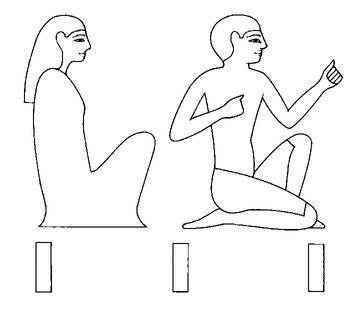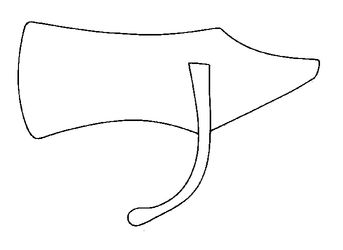Read Think Like an Egyptian Online
Authors: Barry Kemp
Think Like an Egyptian (25 page)
The parallel universe of the Otherworld and the journey of the sun-god with whom the deceased king merged were likewise perpetually under threat from enemies called “the gang of Seth.” They personified the forces of disturbance, and existed to be cast down and to receive punishment. They walked upside down, ate their own excrement, were dismembered and defleshed; their shadows were destroyed. They were assigned to an “outer darkness” and to a “slaughtering place” where they were punished in fiery pits and cauldrons by demons who were some of the dead.
In real life, enemies of the king or those who transgressed against the gods also faced harsh punishments: death by impalement or burning (though the high-born conspirators who plotted against Rameses III were allowed to take their own lives).

62.
BOW
The use of the bow extends back to the Stone Age. In a cemetery at Gebel Sahaba beside the Nile in northern Sudan, dating to around 10,000 BC, many of the dead had been pierced by flint arrowheads. For a long time Egyptians used a “simple” longbow, usually between 1.3 and 1.7 meters long, made from various types of wood, including acacia, and bent to shape by holding it under tension in steam for some time. Early in the New Kingdom, however, as part of the radical change in weapons and tactics, when Egyptians adopted the practices of their enemies in the Near East, they began to manufacture shorter but more powerful composite bows made from a core of wood with a layer of sinew on the back and horn on the front. Without its string and no longer under tension, it fitted into a long triangular box, often decorated, which became a conspicuous accessory on the side of chariots. The youthful Amenhetep II would have used a bow of this kind to pierce a bronze target with his arrows (see no. 7, “To appear,” and no. 54, “King”).
The bow, an image of war, became a symbol of the king’s enemies, collectively known as the “Nine Bows,” though why nine was significant is not known. The Egyptians created a design in which groups of three of these bows alternated with pictures of ethnically differentiated foreign captives, then drew it where the king would set his feet, such as in areas of painted flooring in the palace that led to the throne, on his footstool, even on the soles of his sandals. Thus the king would constantly trample on his enemies. Nubia, a stretch of the Nile Valley that extended southward from Aswan and the ancient Egyptian frontier, was particularly identified with the bow and known as “the land of the bow,”
 T3-Sty
T3-Sty
(
Ta-sety
)
,
using an archaic word for “bow.” Its inhabitants were “the bowlanders.” The Egyptians in time turned this to their advantage, so that “the bowmen of Kush” (another term for Nubia) took their place in the Egyptian army.
 T3-Sty
T3-Sty(
Ta-sety
)
,
using an archaic word for “bow.” Its inhabitants were “the bowlanders.” The Egyptians in time turned this to their advantage, so that “the bowmen of Kush” (another term for Nubia) took their place in the Egyptian army.

63.
MAN AND WOMAN
Most of what we know about ancient Egypt derives from a tiny minority of affluent men. These were the literate officials who were often landowners as well. A few of them, who gained lasting reputations (such as Ptahhetep), recorded their views on life in manuals of good conduct written for their sons and fellow men. They pay little attention to women. When they do, they can be generous toward them.
Good speech is more hidden than greenstone, yet may be found among maids at the grindstone.
But more often patronizing at the same time.
Do not control your wife in her house when you know she is efficient. Do not say to her, “Where is it? Get it!” when she has put it in the right place. Let your eye observe in silence, then you will recognize her qualities. It is a joy when your hand is with her.
Fill her belly, clothe her back. Ointment soothes her body. Gladden her heart as long as you live. She is a fertile field for her lord.
A more direct expression of misogyny is found in the short and cynical precepts of Ankhsheshonk (though several centuries later than the other sources). To him, women are grasping, unreliable, and stupid: “Instructing a woman is like having a sack of sand whose side is split open.” We have so few records made by women that it is not possible to build up an independent picture of how they viewed their role or their men.
We can infer how men and women behaved toward one another by studying individual instances. Relations were the outcome of constant negotiation within a social system that gave to men the greater share of overt authority but did not prescribe a particular place to women. Men obliged to be away from home might leave their wives to run the household. The priestess Henut-tawy wrote to her husband, with a frankness that suggests mutual confidence, to record how, when she checked a consignment of grain, she found several sacks missing. On hearing the men’s excuse, she took it as a prelude to further disasters: “I kept my silence at that moment, saying, ‘By the time you return the god Amun will have done every bad thing with me.’ ” Some women, perhaps through widowhood, found themselves officially recognized as renters of temple farmland—a common alternative to outright landownership—alongside various ranks of men.
One role for women was of priestess, which gained in status as time passed, particularly during and after the New Kingdom. Many bore the title “songstress” or “chantress” of a god. Pictures show them as part of a group, their body positions suggestive of dancing. Whether they sang in words (none are recorded) or ululated, we do not know. Some of them came from wealthy families and were buried in elaborately decorated coffins accompanied by finely painted copies of the Book of the Dead. Between 870 and 525 BC, among the most prominent people at Thebes, there was a line of “god’s wives of Amun,” although how much temporal power they wielded is hard to know. They lived in a palace attached to the temple at Medinet Habu originally built to commemorate Rameses III, and were buried in vaults beneath small mortuary temples of their own that lay alongside. Each one was the daughter of a king, seems not to have married, and passed the office on to her successor through a process of adoption.
The clearest picture of women’s lives that we have comes from the abundant sources that survive from the workmen’s village of Deir el-Medina and the adjacent town of western Thebes, written during the later New Kingdom. Women wrote short letters to one another, revealing that some of them at least were literate, though we do not know whether they learned at home or were allowed into the scribal schools. Often they addressed each other as “sister,” but this was an expression of affection: “Said by Isis to [her] sister Nebu-emnu: I implore you to weave for me this shawl, very, very quickly, before Amenhetep [the local patron god] comes, because I am completely naked.” Women haggled with passing (male) traders to buy slave girls, they raised crops to sell at market, they joined their menfolk in conspiracy and theft. They appeared in court, though far less frequently than men, accused of theft, nonpayment, selling a building improperly, and neglecting a sick relative. When faced with proof that the lady Herya had stolen and buried a bronze chisel and a piece of bronze sacred image, the court declared her worthy of death and handed her over to the jurisdiction of the vizier (with what result we do not know). Outside the probably all-male scribal offices women and men seem to have shared a wide range of experiences. Theirs was not a segregated society.

64.
RAZOR
Apart from a time in the Old Kingdom when small mustaches came into fashion, during none of the historic periods did men retain facial hair. Full beards were one sign of being foreign. Thus shaving must have been a regular feature of daily life for men. Many examples have been found of implements of the shape of the hieroglyphic determinative for “razor,” the flat blade of copper or bronze attached to a curving handle, often of wood.
The actual bodies of ancient Egyptians, when sufficiently well preserved, show that men cropped their hair fairly close and sometimes completely shaved the scalp, but that women often grew their hair long. Both men and women could change their appearance by using artificial hair additions. They could thicken or lengthen their hair by tying in extra pieces, as did an 11th Dynasty soldier from a mass grave who had thickened his hair with tightly wound additional spirals, or Queen Tetisheri, whose thinning white hair had been supplemented with more substantial braids of brown.
To enhance their status, however, and give the impression of having longer hair elaborately prepared, Egyptians preferred wigs. The foundation was a netting cap usually made of hair itself. Woven into it were plaits, with braids or curls, depending on the preferred style, braids reaching up to 50 centimeters in length. Warmed beeswax or resin was used as a setting agent. By the New Kingdom the fashion for men was a two-layered wig, the lower of long thin plaits (up to several hundred of them) and the upper of open-center curls. When not worn, wigs were kept in boxes. Women’s wigs were less elaborate and so appeared more naturalistic. Most of our information on the Egyptians” appearance comes from statues and pictures from their tombs, in which they show themselves to best advantage. We have no way of knowing for how much of a day people would actually wear the larger wigs.
For male priests on duty in the temple, hair was a sign of impurity, even though the gods themselves were often shown wearing heavy wigs. The statement by Herodotus that Egyptian priests shaved their bodies all over is at least partly borne out by the many depictions of priests, especially in later periods, with shaven heads, although this was not as important as purification through washing and the use of natron (see no. 3, “Grain”). That the large temple of Amun at Thebes maintained on its staff a “chief of barbers of Amun” implies the presence of a whole team to make sure that the priests kept to the required standard of cleanliness. The association of hair with ritual uncleanliness seems not to have applied to priestesses, however.
Other books
The Spur of the Platypus by Jackie Nacht
Something Borrowed by Louisa George
Eternal: More Love Stories With Bite by Anthology
The Gauntlet ( A Fantasy Novella) by Michael Diack
61 A.D. (Bachiyr, Book 2) by McAfee, David
Strawberry Fields by Katie Flynn
Ugly Ducklings Finish First by Gail, Stacy
Karma by Susan Dunlap
The Escort by Raines, Harmony
